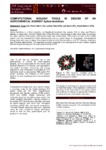Por favor, use este identificador para citar o enlazar este ítem:
http://www.alice.cnptia.embrapa.br/alice/handle/doc/1032282| Título: | Computational biology tools in design of an agrochemical against Xylella fastidiosa. |
| Autor: | FULAZ, S. F.  CABRINI, F.   TASIC, L.   BORRO, L.   NESHICH, G.   |
| Afiliación: | STEPHANIE F. FULAZ; FLÁVIA CABRINI; LJUBICA TASIC; LUIZ BORRO; GORAN NESHICH, CNPTIA. |
| Año: | 2015 |
| Referencia: | In: CONGRESSO DE INICIAÇÃO CIENTIFICA DA UNICAMP, 33., 2015, Campinas. [Proceedings...]. Campinas: Unicamp, 2015. |
| Descripción: | Xylella fastidiosa is a Gram-negative, non-flagellated bacterium that causes CVC in citrus and Pierce?s disease in grapevines. The CVC affects 40% of the 200 million orange trees in São Paulo state. It colonizes the xylem vessels of the plants, blocking the water and nutrient flows. PilT protein is a part of the motility system and very important for Xyllela pathogenicity and our protein target for drug design. Computational biology tools were used to design the compound able to inhibit the formation of the PilT hexamer, leading to loss of Xyllela pathogenicity. This approach could be employed in the development of new inhibitors against different targets belonging to the same protein family of PilT. |
| Thesagro: | Xylella Fastidiosa |
| NAL Thesaurus: | Bioinformatics |
| Palabras clave: | Bioinformática PilT Ferramentas de biologia computacional Computational biology tools Biology |
| DOI: | 10.19146/pibic-2015-38174 |
| Tipo de Material: | Resumo em anais e proceedings |
| Acceso: | openAccess |
| Aparece en las colecciones: | Resumo em anais de congresso (CNPTIA)  |
Ficheros en este ítem:
| Fichero | Descripción | Tamaño | Formato | |
|---|---|---|---|---|
| computationalFulazpibic.pdf | 589.01 kB | Adobe PDF |  Visualizar/Abrir |









